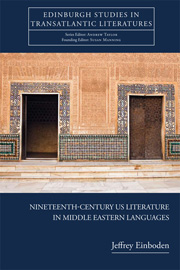Book contents
- Frontmatter
- Contents
- Acknowledgments
- Dedication
- Introduction
- Part I Scriptural Circulations
- Part II Orienting the American Romance
- 3 Inscribing the Persian Letter: Hawthorne and Sīmīn Dāneshvar
- 4 Navigating the Arabic Whale: Melville and Iḥsān 'Abbās
- Part III ‘I too am untranslatable’: Middle Eastern Leaves
- Notes
- Bibliography
- Index
4 - Navigating the Arabic Whale: Melville and Iḥsān 'Abbās
from Part II - Orienting the American Romance
Published online by Cambridge University Press: 05 October 2013
- Frontmatter
- Contents
- Acknowledgments
- Dedication
- Introduction
- Part I Scriptural Circulations
- Part II Orienting the American Romance
- 3 Inscribing the Persian Letter: Hawthorne and Sīmīn Dāneshvar
- 4 Navigating the Arabic Whale: Melville and Iḥsān 'Abbās
- Part III ‘I too am untranslatable’: Middle Eastern Leaves
- Notes
- Bibliography
- Index
Summary
On prominent display at the Berkshire Athenaeum's ‘Herman Melville Memorial Room’ are four small pieces of coloured tile. Trivial in size, the significance of these ceramic fragments is clarified by an accompanying entry from Melville's 1856–7 journal – the diary of his travels in Greece and the Middle East. Writing under the date 6 December 1856, the American records his day spent in Thessalonica, exploring the city's antique sites:
Went into the mosques […] Several of the mosques formerly Greek churches, but upon the conquest of the Turks turned into their present character. One of them circular & of immense strength. The ceiling mosaic. Glass. Pieces continually falling upon the floor. Brought away several.
This abrupt sketch of remembered images offers an apt place to begin consideration of Melville and Middle Eastern translation. Touring spaces which straddle two sacred histories – buildings which comprise Muslim revisions of European originals – the American is particularly attracted to a site of ‘strength’ and ‘circular[ity]’. Focusing his attention further upon its ‘ceiling mosaic’, Melville discovers this mosque-church to be not only religiously hybrid, but also dynamic in architecture, still transforming before his eyes, with ‘Pieces continually falling upon the floor’. The above entry concludes with Melville himself becoming a participant in the unfolding life of this ‘mosaic’ building; first a ‘Greek church’, then ‘turned’ by the ‘Turks’, the ‘present character’ of this shrine is translated further with Melville carrying ‘away’ fragments, bringing these synthetic memorials back across the Atlantic.
- Type
- Chapter
- Information
- Publisher: Edinburgh University PressPrint publication year: 2013

